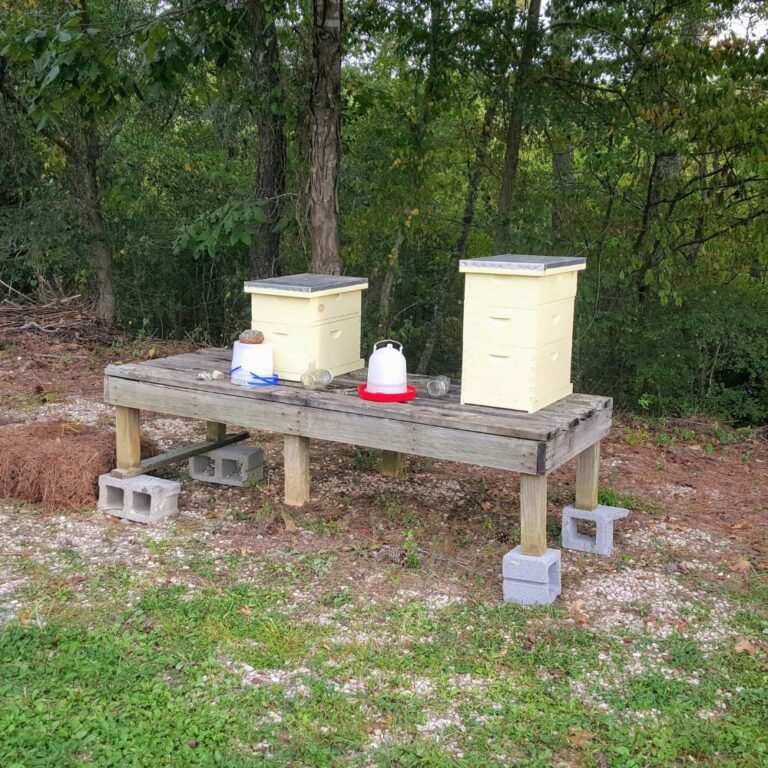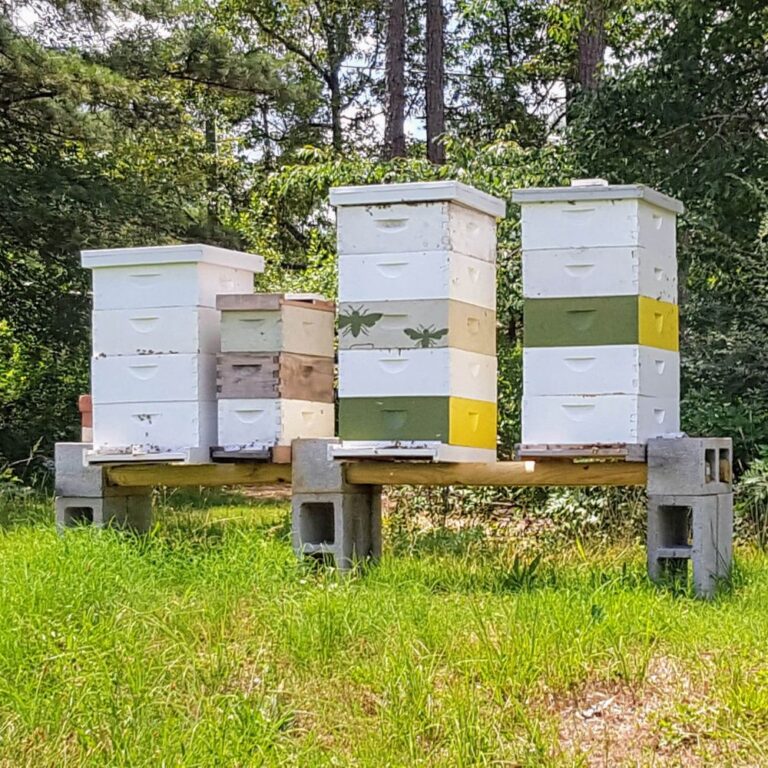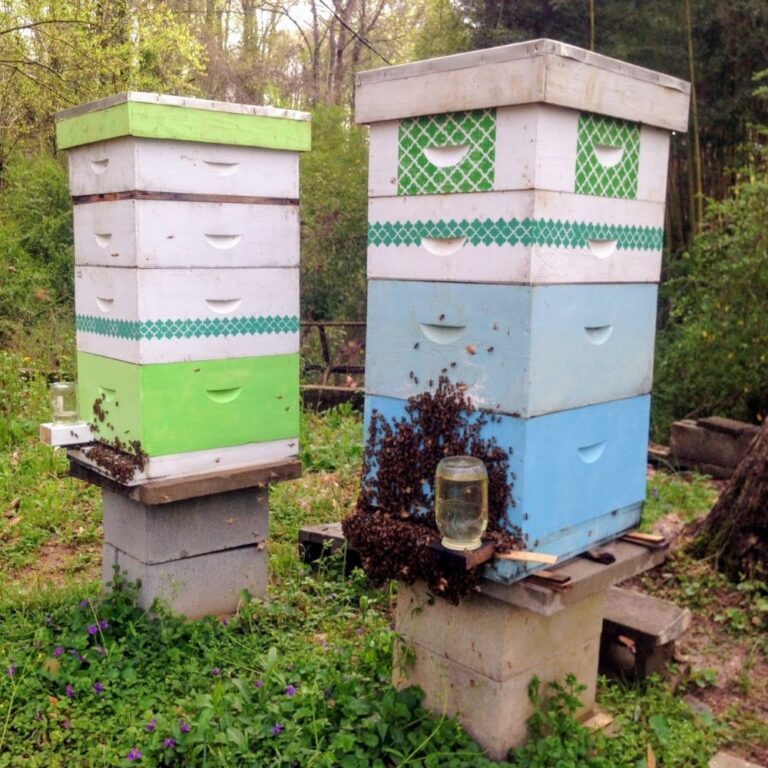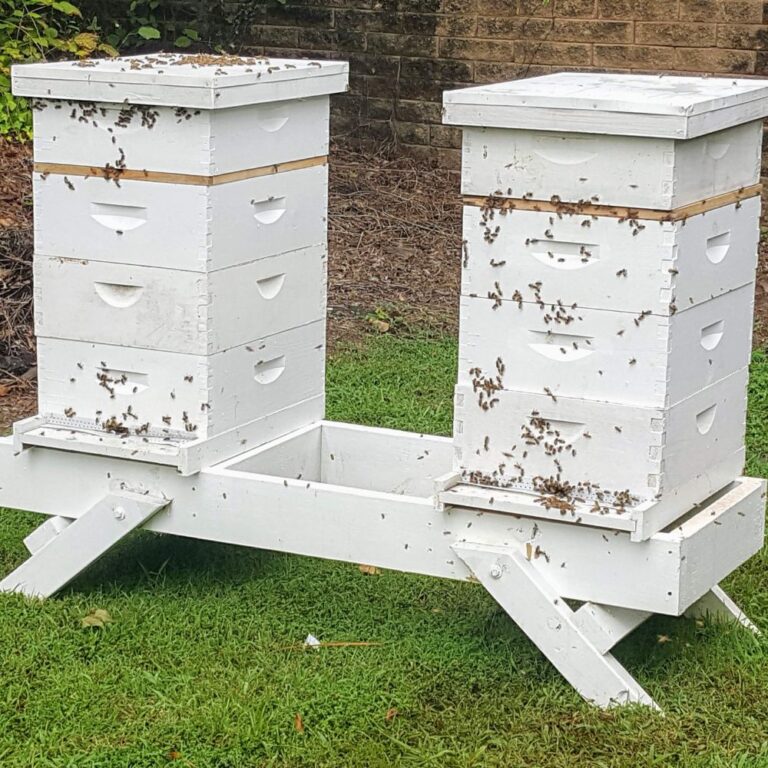Table of Contents
When you are getting your bee hives set up, it’s important to take into account where you are going to put a beehive. You should consider the location of your bees, facing the east or southeast, dry spot, east to access, etc… But nobody talks about what to put your hives on.
You would think you could take the bottom board and set it directly on the ground, but we advise against that. Even the cypress hives that we have are rot-resistant, but eventually, they will rot when they are placed directly on the ground.
Preventing rotting wood is one reason you don’t put the hives directly on the ground, but it’s also harder on the bees if you don’t use a hive stand. You want the colony to stay drive-end free of excess humidity. When the hive sits directly on the ground, you invite wet, moist air into the hives year around. And if you get a big rain, the water will just run into the hive.
The ground can also be soft, and if a hive is placed on the ground, the weight of the hive may cause the bottom board to sink directly into the soil. Plus, you’ll get ants in your hive more easily, as well as raccoons, skunks, opossums, etc… will all have easy access. Just trust us; you want to put your hives on a sturdy hive stand. Hives sitting directly on the soil are asking for issues.
There are several options for keeping your hives dry. Over the years, we have seen most beekeepers place their hives on cinder blocks. A cinder block beehive stand is probably the easiest option for most beekeepers. They are cheap, easy to move, and mostly indestructible. We have used them for many of our hives when we need something quick.
The other end of the spectrum is metal hive stands. There is a wide variety of metal hive stands available, and they aren’t all the same. We have one that we use with our hives, and we also carry it in our store. If you want a hive stand that is built extremely well, versatile, and will serve you well for years, we recommend this metal hive stand.

Rules For All Hive Stands
Regardless of the type of hive stand that you use, you want it to meet as many of these qualities as possible.
Will hold at least 300lbs
It can be made level
Will hold your hive securely without concern for tipping over
Water, rust, and rot resistant
Will last for at least 2-3 years
8-16 inches off the ground
The bee hives stand needs to be made very well as you don’t want to adjust them after the colonies are placed on them. Most beekeepers keep a Langstroth hive, but if you use another type of hives like a Top Bar Hive, Layens Hive, Warre Hive, or any others, these rules apply. As is the case with many of these other types of hives, you may have to make a custom hive stand for them. A cinder block hive stand is the easiest to adjust if you have a unique hive.
Cinder Blocks
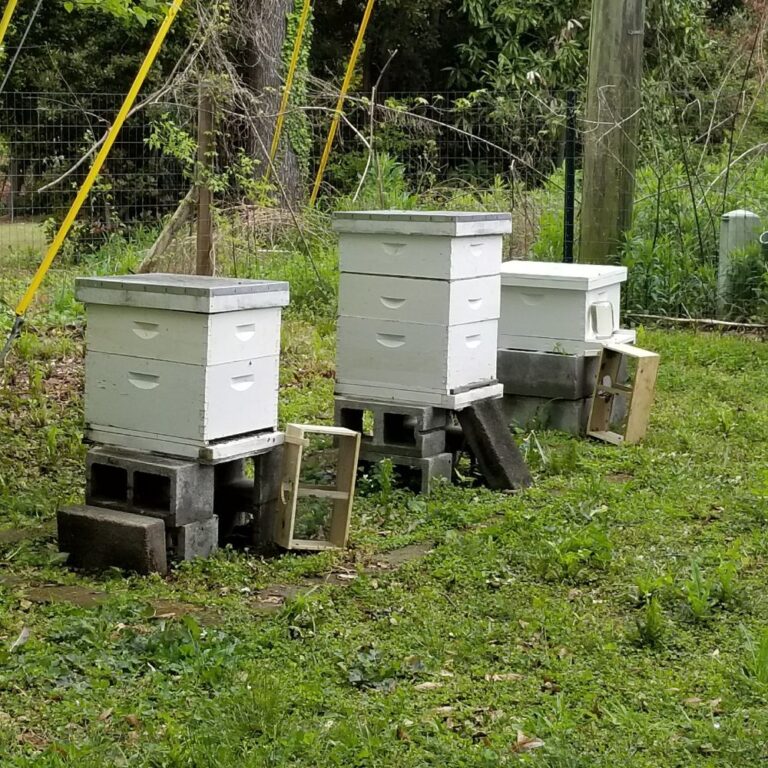
When setting up a hive using cinder blocks (Not foam ones), you only need 2 blocks. If you use 4 blocks, it starts to make the hive too high. You don’t want to start the colony too far off the ground because once you start stacking the honey boxes on the hive, it can get pretty tall. Two cinder blocks are just about the right height of the ground. If you set them on their side with the holes going up and down, any debris that falls through the screened bottom board will fall onto the ground. The 2 cinder blocks are wide enough to hold a 10-frame or 8-frame hive.
You will have to set these up for every hive, so if you have multiple hives, you should keep that in mind. While cinder blocks may seem cheap, the honey bees don’t care. A cinder block isn’t pretty, so if you want something a little nicer, then spring for a wooden hive stand or a metal hive stand.
Wooden Hive Stand
There are many versions of a wooden hive stand because this is the most common DIY bee hive stand. With a couple of boards and screws, you can make a very reasonable hive stand. A couple of power tools make the job easier, but you could just have Home Depot, or Lowes cut the boards for you.
When you use a wooden hive stand, it’s important to use pressure-treated wood. You may not think that treated wood is a good idea for a hive stand because you don’t want it near the bees, but the hive stand is separate from the colony, and the chemicals used in the wood don’t interact with the bees.
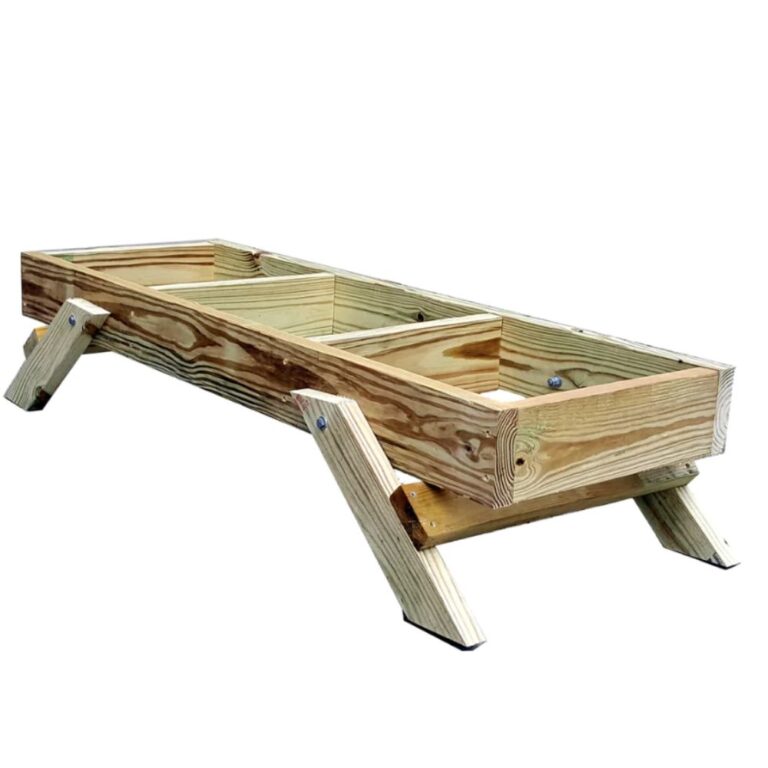
When using a hive stand made from wood, we would recommend placing the open end of the legs on a brick or paver. Doing this will keep the wood from touching the ground and wicking up moisture, causing the wood to rot faster. We have sold these folding beehive stands for since 2014 and love them. We have some that have been in use since then and are not showing any signs of rot.
If using wood for a hive stand, we recommend not using 2x4s for the stringers. These are the boards that the colony rests on. If you use the stand to hold 2 or more hives, you must use 2x6s or 2x8s. A 2×4 will bend under the weight of the colonies, trust us. If it starts to bow, the boards can break, and the hives collapse. If this starts to happen, you can place additional cinder blocks under the boards to keep that from happening.
Metal Bee Hive Stands
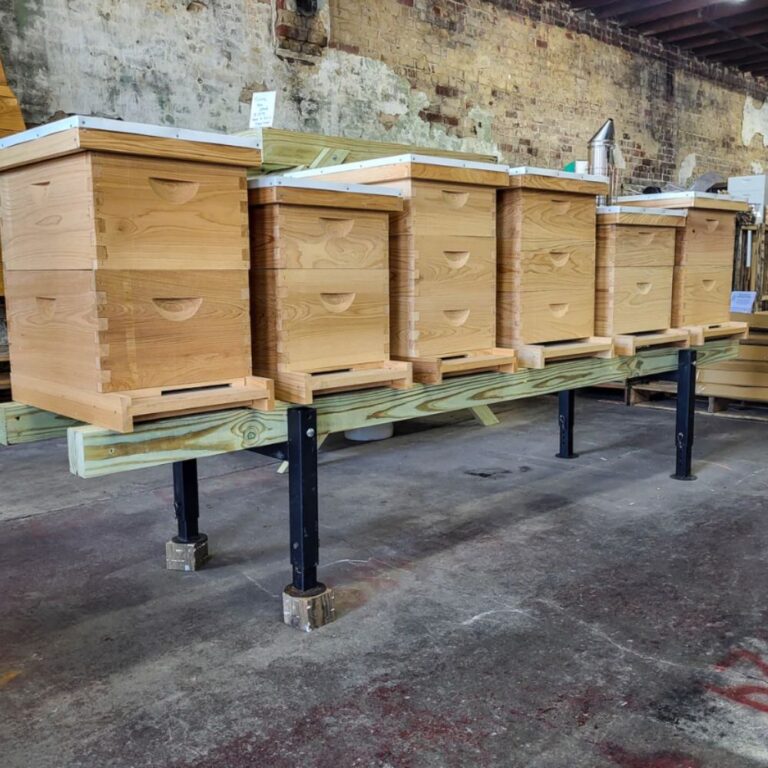
A metal hive stand could potentially be the strongest of all. We have seen many versions, some of which are built extremely well. Others are made of rebar and don’t have a great design.
The bee hive stand we have seen made from rebar have metal rails that hold the colony and rebar that is curved to give it a frame. The problem we see most with these is that the rebar will sink into the ground under the hive’s weight. So if using a rebar hive stand, you want to ensure the feet are sitting on pavers or bricks. The weight of one beehive can easily get to over 300 lbs.
The best metal hive stand we have seen is the one we sell. It is designed with adjustable legs to change its height, one leg at a time to match the terrain. The metal is coated with rust-proof paint, and the steel is exceptionally thick and welded well. What is nice about this hive stand is that you supply your own wooden boards.
So the legs are made from steel, but the stringers can fit a 4×4, 2x6s, or 2x8s. The legs will hold several tons so you could add boards 16′ long or longer for the hives to set on. The best part is the metal legs are shipped with all the hardware, so all you have to do is add the boards that fit your purpose. We put one together and put 20′ boards on it, and it works perfectly.
Pallet Hive Stands
The pallet hive stand is usually used for the commercial beekeeper instead of the beginner beekeeper. The reason professional beekeepers use the pallet hive stand is it is possible to move 4-6 hives with a forklift at once. That is a huge benefit over moving one hive at a time. Most commercial beekeepers have to move colonies on, and off trucks, so easy transport is a huge plus.
You will commonly hear these pallets called 4-way or 6-way pallets because they have a special hive entrance that is built directly into the stand. With a pallet stand, they don’t have a bottom board, but instead, the hive box is sitting directly on the pallet. These pallets are custom-made for this purpose, which is why it isn’t popular if you are backyard beekeeping. While they are called pallets, they are not the standard pallets you see in shipping.
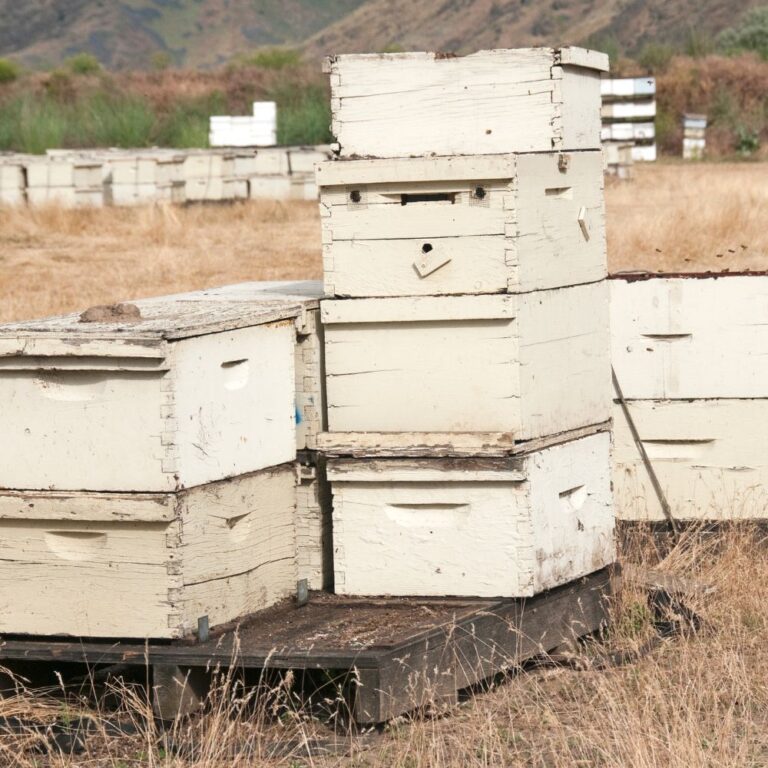
They are the same height as these pallets, which is a negative. With the low hive entrance, it’s easy for pests and grass to grow up into the entrances. But these pallets are not in the same location for more than a couple of months, so that usually isn’t a problem.
Plastic Hive Stands
We don’t see these often when we help customers with their bees, but a plastic hive stand for a bee colony is also an option. These are either custom-made for beekeeping, or they are made from PVC, a DIY hive stand. We have never used one, but they do seem a little bulky and expensive for what they are. If we are going to have a stand for only one hive, it is going to be made with cinder blocks.
This is the plastic hive stand we see the most, and it is available on Amazon. I wouldn’t trust it with one of our colonies, but it is an option.
If we are making a hive stand for multiple hives, it is going to be made from wood or steel. Plastic will get brittle over time, and even UV-treated plastic will break down under pressure from the sun and the weight of the colony over time. And I would rather not have to find a colony that has fallen over and put it back together.
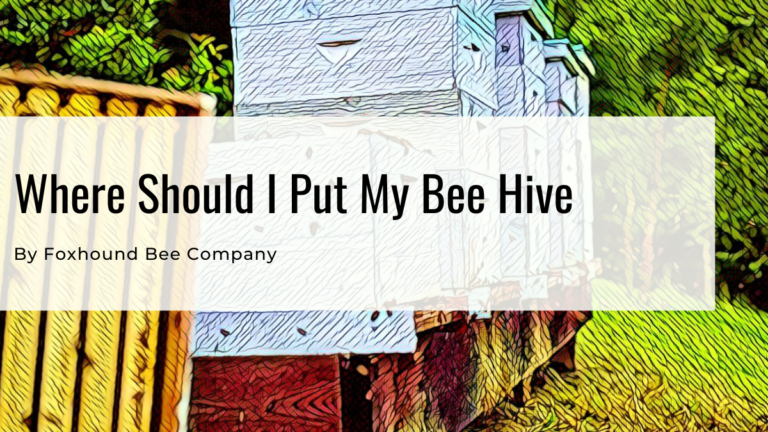
Where Should I Put My Bee Hives?
Finding the right spot to place your bees is very important. It’s hard to move bees from one location to another if you don’t have
